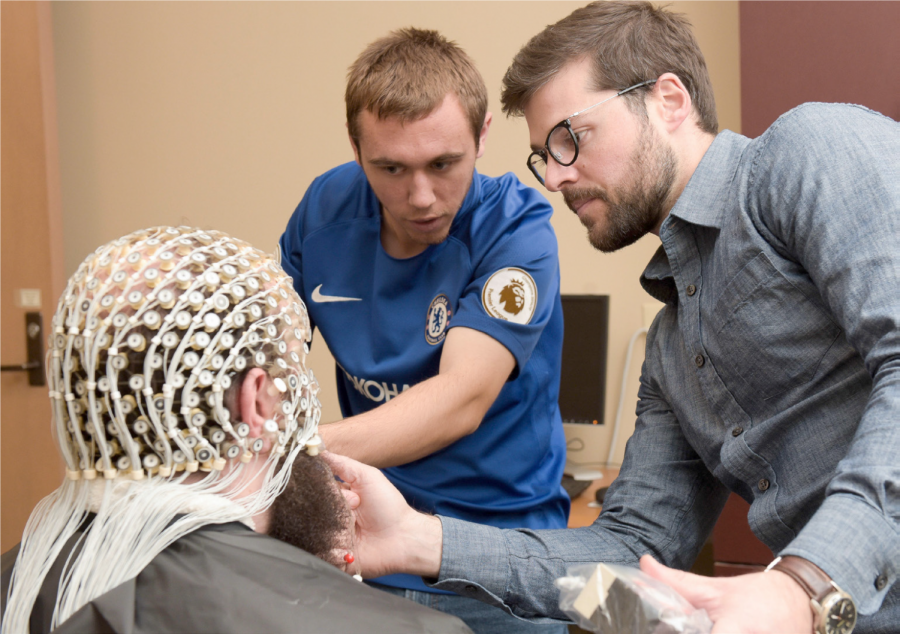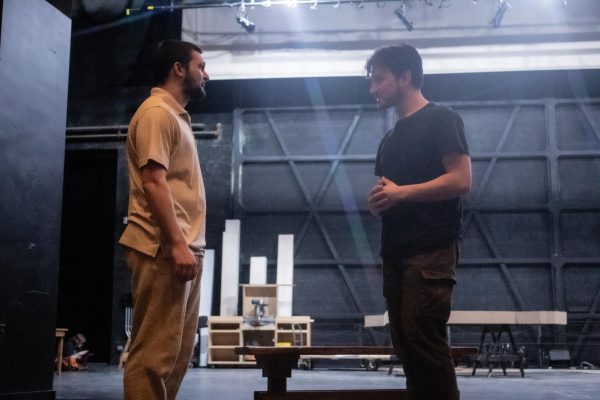Students gain hands-on experience in new lab
First BW studies of brain activity now underway
Baldwin Wallace’s newest lab facility is now complete. This October marked a new accomplishment in the world of technology for one of Baldwin Wallace’s very own assistant professors.
Dr. Patrick Ledwidge, assistant professor of psychology, recently brought BW’s cognitive-communications lab to completion, over a year after he began the project in December 2016.
According to Ledwidge, the cognitive-communications lab is used primarily to measure brain activity, test theories, and determine how injuries affect the brain using a brain imaging technique called EEG, or electroencephalogram. With the EEG, Ledwidge has hopes to revise existing theories of how the brain comprehends language.
“[The first project] will study how the brain understands meaning within written language, so really during reading, how the brain figures out what a piece of text is about, more so than just what does a single word mean,” said Ledwidge.
Ledwidge was inspired by the EEG labs he encountered during his time at the University of Nebraska-Lincoln, which gave him the motivation to develop his own lab on BW’s campus.
However, despite his previous experience working in EEG labs, Ledwidge still experienced a learning curve when creating his own.
“I had to learn a lot about how much space I would need, how much lighting to use,
what type of air circulation we would need… It really just came down to the nitty-gritty of everything and designing the new space,” said Ledwidge. “It was my first time doing it, so I had to learn a lot, and I worked a lot with the Buildings and Grounds here at BW. They were really great at helping me construct the space.”
The cognitive-communications lab is currently located in the old staff and faculty lounge upstairs in the Malicky Center for Social Sciences. According to Ledwidge, the room was split into three sections, with one large space intended for collaboration, and two smaller rooms that are split off from that with a window passing between them. It is in these two smaller rooms that the research actually happens.
“It was a really big process,” Ledwidge said. “Not only the lab in terms of personnel, but constructing it was a really big task.”
In the fall, Ledwidge plans to study how sports-related concussions affect brain activity that supports language.
“I think right now, the overarching aim is to identify how head trauma changes the brain over time,” Ledwidge
said, “specifically how it may change the brain activity that supports our ability to interact and communicate and support our daily interactions.”
This lab has already had an mpact on BW’s psychology students. Jeremy Foust, a junior majoring in psychology and the president of the Psychology Club, was said to have felt highly benefitted by the addition of the new lab.
“I definitely feel that this lab has given me multiple skills to add to my Resume and CV,” said Foust. “Graduate programs want to see that you are involved in research and this lab adds to my research.”
According to Foust, working in the cognitive-communications lab has also granted him an extensive set of “soft skills” including teamwork, data collection, and interacting with study participants.
“So far we’ve been setting up the lab and preparing for this semester,” said Foust. “Dr. Ledwidge, Adam Ramsey, and myself are writing an article about setting up an EEG lab at a Primarily Undergraduate University.”
Ledwidge hopes this lab will continue to be beneficial for students like Foust, both in terms of their resume and the soft skills they will develop.
The Exponent is looking for financial contributions to support our staff and our newsroom in producing high-quality, well-reported and accurate journalism. Thank you for taking the time to consider supporting our student journalists.













































